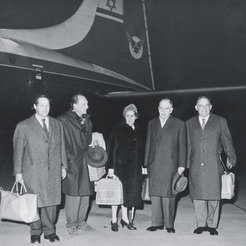History of the Minerva Stiftung
Today, the Minerva Stiftung, founded in the 1960s as a subsidiary of the Max Planck Society, is the flagship of German-Israeli scientific cooperation. It is financed by the Federal Ministry of Education and Research, and works closely with leading universities and research facilities in Israel.

In 1959, a delegation of the Max Planck Society, headed by its president Otto Hahn, visited the Weizmann Institute of Science in Rehovot. After a long time of diplomatic silence, the scientific contact between researchers of these two institutions marked the beginning of a new chapter in public relations between Germany and Israel. Following this meeting, the German government provided a starting capital of DM three million for future research projects and the exchange of scientists and researchers with the Weizmann Institute.
In 1964, the Minerva GmbH, now the Minerva Stiftung GmbH, was established as a subsidiary of the Max Planck Society. Minerva concluded an agreement with the Weizmann Institute, thus forming the legal basis of the Minerva Weizmann Programme as the first of several German-Israeli scientific exchange programmes. Even today, the political and scientific importance of this agreement remains unchallenged and is recognised by the fact that the German Federal Ministry of Education and Research provides the Minerva Weizmann Programme with an annual amount of € 3,650,000.

The year 1973 marked another milestone in the exchange between German and Israeli researchers, as the beginning of the Fellowship Programme was announced, which made scientific exchange between all German and Israeli research institutions possible. Since then, about forty German and Israeli scientists have been awarded a funded research residency every year. With the Gentner Symposium, another instrument of funding cooperative German-Israeli research was initiated in 1973. Together with the Minerva Schools, which were implemented in 1997, these funding formats aim at promoting junior scientists and explore new topics for the German-Israeli context. Both facilitate initial contacts between scientists in Germany and Israel in special fields of research.
In 1977, German governmental funds were used to set up the first Minerva Center at an Israeli university. The initiative was based on the wish to broaden the scope of German-Israeli cooperation in basic research. Selected research fields considered as important to both sides and likely to yield particular scientific successes were to receive special promotion and to be explored in Israel. Today, 23 Minerva Centers are working in all fields of science in Israel, and every other year, a call for up to three new Centers is announced.

In 1987, during the redirection of the Minna-James-Heineman-Stiftung, another funding format for young German and Israeli scientists was introduced when an agreement was signed between the Max Planck Society and its subsidiary, the Minerva Stiftung, the Heineman Stiftung and the Weizmann Institute of Science. With the interests of the endowment capital of Heineman, now specially devoted to strengthen German-Israeli cooperation in general and between Max Planck and Weizmann in particular, a new opportunity for scientific cooperation and exchange was created and has been administered by the Minerva Stiftung ever since since.
In 2008, the Ministry of Education and Research had the idea to introduce a prize for excellent scientific research cooperation between Germans and Israelis and assigned the Minerva Stiftung to develop a substantial concept and integrate it into its funding formats. With ARCHES, the Award for Research Cooperation and High Excellence in Science, every other year three outstanding joint research teams, headed by Germans and Israelis, receive a well-endowed prize as an acknowledgement for their excellent work.
Since 1964, the German Federal Ministry of Education and Research has provided the Minerva Sitiftung with more than € 350 million. The successful evaluation of the Minerva Programmes in 2005 and the ongoing attractiveness of the existing funding formats makes the Minerva Stiftung the leading institution for scientific exchange and cooperation between Germany and Israel.














